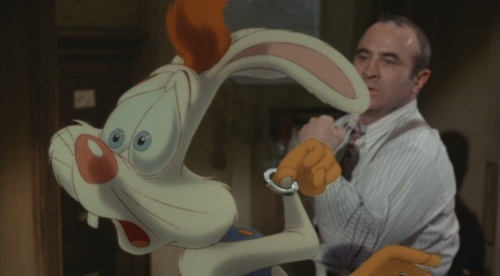I wouldn’t be so presumptuous as to think I could write an obituary of Joe Grant, the veteran Disney artist who died on Friday: try Jim Hill Media or LaughingPlace for that. But I did want to write a little bit about what a symbolic moment this is, particularly coming so soon after the death of legendary animator Frank Thomas (the second-last of Disney’s so-called “Nine Old Men”) last September.
disney
Bambi (David Hand, 1942)
Bambi was the last great Disney cartoon. It was the last in his amazing run of features between 1937 and 1942 (following Snow White, Pinocchio, Fantasia, and Dumbo), and was in many ways the climax of that sequence. After Bambi the studio would never quite be the same again: a divisive strike, financial difficulties, and World War II would see Disney give up on true feature film production for the rest of the forties. For all their virtues, the features he would make later (starting with Cinderella in 1950) never reached the heights of these first five features. Bambi, with its cute baby animals and impeccable animation, is also probably the film that epitomises the common perception of Disney films.
The news in the last couple of weeks that Roy E. Disney (and another board member, Stanley Gold) have resigned from the board of the Disney corporation after disputes with Michael Eisner draws attention to the depressing future that faces the studio. I have no inside knowledge of the studio, so have no idea how effective Roy E. was as a board member. But even if his role was purely ceremonial, the symbolism of what’s occurred is bad enough. Roy E. Disney is Walt Disney’s nephew, and the son of studio co-founder Roy Disney. Given the elder Roy’s much larger then generally understood role in the studio’s operation (he ran the business end until after Walt’s death, and the studio was initially the “Disney Brothers” studio), Roy E. represented a direct, tangible link to the heritage of the company, which has always been its greatest asset. It’s long been easy – and largely accurate – to disparage Disney as just another soulless media conglomerate, but Roy E. was still there as a human link to the glory days of the thirties when Walt blazed his trails. (Sure Roy E. was just a kid at the time, but we’re talking symbolism here).
Finding Nemo (Andrew Stanton), 2003
Here’s one for those who like conspiracy theories: during 2003, Steve Jobs (head of Pixar animation studios) and Michael Eisner (head of Disney) were renegotiating the deal that allowed Disney to distribute Pixar’s films. With four straight hit films under their belts – Toy Story, A Bug’s Life, Toy Story 2, and Monsters Inc – Pixar had a strong bargaining position, and Disney expected their cut of the profit from Pixar films drastically reduced. Yet in 2002 and early 2003, rumours circulated that the upcoming Pixar movie, Finding Nemo, was not up to the standard of its predecessors. This put a small, but significant question mark over the future of Pixar – was their strong negotiation based on past glories, rather than a realistic assessment of what might be to come? Were Pixar due for a fall? Ultimately, the negotiations dragged on until Finding Nemo was released – whereupon it received universally positive reviews and eclipsed Disney’s The Lion King as the highest grossing animated film ever. Pixar’s status as the studio that could do no wrong was protected, and the cloud over the negotiations lifted. But here’s the question – could Disney possibly have started the bad buzz on Nemo to force their hand?

Who Framed Roger Rabbit? (Robert Zemeckis, 1988)
When people talk of the revival of animation in the 1990s, they tend to date the start of the resurgence from Disney’s 1989 feature The Little Mermaid. Certainly there is more continuity in personnel between The Little Mermaid and the 90s hits (such as Aladdin, Beauty and the Beast, and The Lion King) than there is with Who Framed Roger Rabbit. Yet I would argue that the strength of the 90s boom came from the fact that it crossed over into adult audiences: this is clearer when one looks past just the Disney films and considers the full array of animation that sprang out of this period, which includes not only the wave of excellent computer animation (Toy Story, Antz, Monsters Inc, Shrek) but also television work (“The Simpsons,” “Futurama,” “South Park,” and many others). The fact that adults were prepared to go along to these films, or watch these shows, contributed significantly to their success. Adults did so largely because appreciation of the Hollywood tradition of classical animation had bubbled through to the mainstream. People who grew up with the cartoons of the “Golden Age” of the 1930s to 1950s (a staple on TV from the 1960s onwards) were now adults who appreciated the quality of what they had seen. Who Framed Roger Rabbit, Robert Zemeckis’ elaborate tribute to Hollywood cartoons, served as a marker for this nostalgia, and hinted at the widening of the audience for animation that occurred in the 90s. Yet it still provokes mixed feelings amongst animation fans.
Treasure Planet (Ron Clements & John Musker), 2010
The failure of Disney’s Treasure Planet to attract a theatrical audience has been much discussed: it brought into focus a lot of criticism of the studio that had been quietly bubbling away for some time. The studio suddenly seems a long way from the halcyon days of its early nineties revival, when films like Aladdin, Beauty and the Beast and The Lion King built on the success of 1989’s The Little Mermaid. Back then people were talking of a new golden age in animation, and while that talk hasn’t gone away, they aren’t talking about Disney anymore. They’re talking about computer animation or even television work. Atlantis: The Lost Empire, The Emperor’s New Groove, and Treasure Planet don’t look like a golden age. (Copper at best).